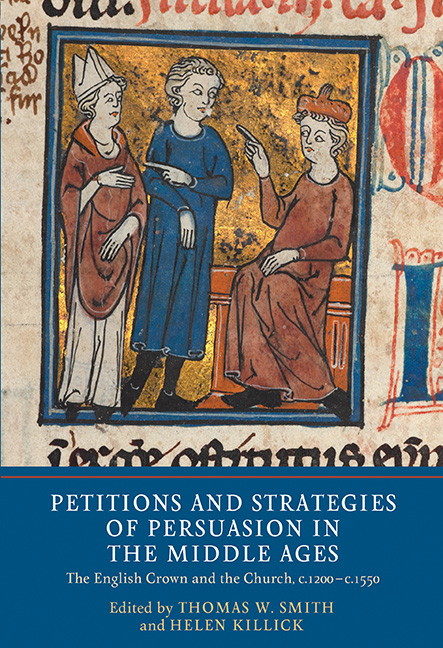 Petitions and Strategies of Persuasion in the Middle Ages
Petitions and Strategies of Persuasion in the Middle Ages Book contents
- Frontmatter
- Dedication
- Contents
- Contributors
- Foreword
- Acknowledgements
- List of Abbreviations
- Introduction: Medieval Petitions and Strategies of Persuasion
- 1 Blood, Brains and Bay-Windows: The Use of English in Fifteenth- Century Parliamentary Petitions
- 2 Petitioners for Royal Pardon in Fourteenth-Century England
- 3 The Scribes of Petitions in Late Medieval England
- 4 Patterns of Supplication and Litigation Strategies: Petitioning the Crown in the Fourteenth Century
- 5 Petitions of Conflict: The Bishop of Durham and Forfeitures of War, 1317–1333
- 6 A Tale of Two Abbots: Petitions for the Recovery of Churches in England by the Abbots of Jedburgh and Arbroath in 1328
- 7 ‘By Force and Arms’: Lay Invasion, the Writ de vi laica amovenda and Tensions of State and Church in the Thirteenth and Fourteenth Centuries
- 8 The Papacy, Petitioners and Benefices in Thirteenth-Century England
- 9 Playing the System: Marriage Litigation in the Fourteenth Century
- 10 Killer Clergy: How did Clerics Justify Homicide in Petitions to the Apostolic Penitentiary in the Late Middle Ages?
- Index
1 - Blood, Brains and Bay-Windows: The Use of English in Fifteenth- Century Parliamentary Petitions
Published online by Cambridge University Press: 20 August 2020
- Frontmatter
- Dedication
- Contents
- Contributors
- Foreword
- Acknowledgements
- List of Abbreviations
- Introduction: Medieval Petitions and Strategies of Persuasion
- 1 Blood, Brains and Bay-Windows: The Use of English in Fifteenth- Century Parliamentary Petitions
- 2 Petitioners for Royal Pardon in Fourteenth-Century England
- 3 The Scribes of Petitions in Late Medieval England
- 4 Patterns of Supplication and Litigation Strategies: Petitioning the Crown in the Fourteenth Century
- 5 Petitions of Conflict: The Bishop of Durham and Forfeitures of War, 1317–1333
- 6 A Tale of Two Abbots: Petitions for the Recovery of Churches in England by the Abbots of Jedburgh and Arbroath in 1328
- 7 ‘By Force and Arms’: Lay Invasion, the Writ de vi laica amovenda and Tensions of State and Church in the Thirteenth and Fourteenth Centuries
- 8 The Papacy, Petitioners and Benefices in Thirteenth-Century England
- 9 Playing the System: Marriage Litigation in the Fourteenth Century
- 10 Killer Clergy: How did Clerics Justify Homicide in Petitions to the Apostolic Penitentiary in the Late Middle Ages?
- Index
Summary
In the course of the first half of the fifteenth century a decisive shift occurred in the language used to write petitions addressed to the king, his ministers and the Lords and Commons in parliament. In 1420 almost all such supplications were drafted in French, long associated as the language par excellence of petitioning. Over the next twenty years, however, English began to be used with increasing regularity. Elsewhere I have estimated that the scales tipped decisively in favour of the English language in the late 1430s, and specifically between 1435 and 1437. From this point onwards it was the predominant language, while the use of French diminished. By the middle of the century, English was chosen as a matter of course. This change is to be found in each of the three main series of petitions, or bills, held in The National Archives: SC 8 (Special Collections: Ancient Petitions); C 1 (Court of Chancery: Early Proceedings); and E 28 (Exchequer, Treasury of the Receipt: Council and Privy Seal Records). In seeking to explain why the language of petitioning changed across the period, I have emphasised the complexity of the dynamics which underlay shifting contemporary attitudes to language, as well as the importance of placing the records in their proper administrative context. Ultimately, the linguistic conservatism of the clerks, scriveners or attorneys who were employed to write petitions, and which had hitherto acted as a seemingly unassailable bulwark against the spread of the vernacular, faltered in the second quarter of the fifteenth century as a result of a number of converging factors: the flourishing of English in a literary context; its broader acceptance as a bone fide language of the court; its adoption in some bureaucratic contexts, notably in letters issued under the signet seal; the laicisation of the writing classes; the onset of Henry VI's majority rule; and the increasingly inward-looking stance of the English political classes, brought about by their defeat in the Hundred Years War and the consequent severing of ties to the Continent.
In a volume of essays addressing the themes of rhetoric and persuasion in petitionary discourse, it seems especially apposite to consider how lexical choice, and in particular the use of English, shaped the tone and content of petitions, as well as the rhetorical possibilities available to those who drafted them.
- Type
- Chapter
- Information
- Petitions and Strategies of Persuasion in the Middle AgesThe English Crown and the Church, c.1200–c.1550, pp. 11 - 39Publisher: Boydell & BrewerPrint publication year: 2018


